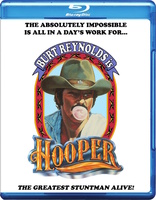Hooper Blu-ray Movie
HomeHooper Blu-ray Movie 
Warner Bros. | 1978 | 99 min | Rated PG | Apr 07, 2015Movie rating
6.6 | / 10 |
Blu-ray rating
| Users | 3.5 | |
| Reviewer | 3.5 | |
| Overall | 3.5 |
Overview
Hooper (1978)
Veteran stuntman Sonny Hooper has long been recognized as the best in the business. When a young rival arrives, the aging Hooper puts his battered body on the line in an escalating contest that his surgeon, friends and long-time companion worry could cripple him for life.
Starring: Burt Reynolds, Jan-Michael Vincent, Sally Field, Brian Keith, John MarleyDirector: Hal Needham
| Comedy | Uncertain |
| Action | Uncertain |
Specifications
Video
Video codec: MPEG-4 AVC
Video resolution: 1080p
Aspect ratio: 1.78:1
Original aspect ratio: 1.85:1
Audio
English: DTS-HD Master Audio Mono (48kHz, 24-bit)
German: Dolby Digital Mono
Spanish: Dolby Digital Mono
Spanish: Dolby Digital Mono (Spain)
Japanese: Dolby Digital Mono
Japanese is hidden
Subtitles
English SDH, French, Spanish, Portuguese, Japanese, German SDH
Discs
25GB Blu-ray Disc
Single disc (1 BD)
Playback
Region free
Review
Rating summary
| Movie | 3.5 | |
| Video | 4.0 | |
| Audio | 4.0 | |
| Extras | 0.5 | |
| Overall | 3.5 |
Hooper Blu-ray Movie Review
Those Magnificent Men Who ARE Flying Machines
Reviewed by Michael Reuben April 2, 2015After the runaway success of Smokey and the
Bandit in 1977, former stuntman-turned-director
Hal Needham could write his own ticket—or as the line goes in his next film, Hooper, "when
your last picture made over a 100 million dollars, you don't have to slobber over anybody".
Needham used his new-found clout to make a tribute to the profession where he got his start, and
the result was an action comedy that was every bit as loud and raucous as Smokey. But Hooper
also has a melancholy undercurrent that distinguishes it from Needham's other comedies and
which may explain why it didn't pack in the same size crowds as Smokey and, later, The
Cannonball Run. As much as the film appreciates the nonconformity, jollity and moxie of the
stuntmen (and stuntwomen) who risk life and limb for the sake of entertainment, it also
acknowledges the toll their work takes on their health and private lives, along with the nagging
awareness haunting every athlete that time is not on their side.
The standing of Needham and star Burt Reynolds in the stunt world was such that they could
literally get anyone and everyone, so that Hooper's stunt "gags" are some of the most elaborate
every captured on film, especially when one considers that everything was done practically,
without the benefit of computer graphics. The concluding sequence, which is supposed to
recreate an earthquake's devastation of a town, involved dozens of stunt players, countless
vehicles, multiple explosions, collapsing towers, crumbling buildings and an exploding bridge,
plus a rocket-propelled car. On a Needham film, there was no such thing as "too much".
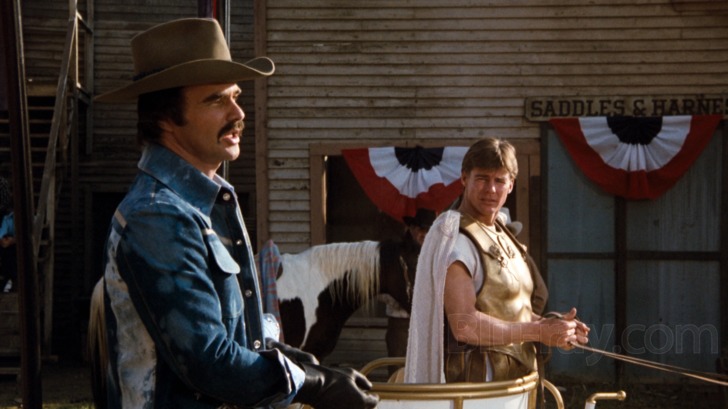
Sonny Hooper (Reynolds) is widely considered to be the greatest stuntman in Hollywood. Currently he's the stunt coordinator for a mammoth spy film entitled The Spy Who Laughed at Danger starring none other than TV's Batman, Adam West (playing himself in an extended cameo), for whom Hooper is doubling. The film, an obvious parody of the Bond franchise (just listen to the soundtrack), is being directed by a narcissistic auteur, Roger Deal (Robert Klein), who has long been rumored to be based on Peter Bogdanovitch, with whom Reynolds had made two previous films (though Reynolds has spoken highly of the director). Deal takes Hooper's work for granted and treats stuntpeople like cattle. Then again, one of Hooper's themes is that stuntmen tolerate being taken for granted in exchange for having all the fun. At least the spy film's producer, Max Berns, appreciates Hooper; he's played by John Marley, who is best known for playing a different film producer, the one who woke up with a bloody horse's head in The Godfather.
On the set, Hooper is all smiles and bravado, but the accumulated years of falls, crashes and punches have taken their toll, and his buddy Cully (James Best) is always near at hand with a few Percodan or a shot of Xylocaine. Hooper refuses to see a doctor, because he doesn't want to hear the bad news, despite the concerns of his long-time girlfriend, Gwen Doyle (Sally Field, who was Reynolds' real-life girlfriend and frequent co-star throughout this period). Hooper would rather party with Gwen's father, legendary stuntman Jocko Doyle (Brian Keith), who was the Hooper of his generation. (Jocko was based on Field's stepfather, Jock Mahoney, who doubled for Errol Flynn, John Wayne and Gregory Peck, among many others.) As Jocko advises an up-and-coming stuntman: "You oughta drink more! Nothing hurts when you're numb."
The script adds a dash of conflict with a new kid in town named Delmore Shidski (Jan-Michael Vincent), promptly nicknamed "Ski" by Hooper and the gang. A fit and ambitious daredevil, Ski is clearly the next Hooper, but the relationship between the two men quickly becomes more a matter of initiation than rivalry. Needham and Reynolds have too much respect for the stuntman's world to portray Hooper and Ski as cutthroat rivals. Whatever competition may exist between them, stuntmen have to look out for each other, because no one else will—certainly not a soulless director like Roger Deal, who doesn't care about injuries, as long as he gets his shot.
While Ski is gradually accepted into the clan, and Hooper finally gets the bad news that his much-abused back is on the brink of collapse—"If you were a horse, I'd shoot you", says the doctor, when Hooper finally sees him—Needham finds excuses to stage one action sequence after another, many of them drawn from his own experiences. There's the bar fight to top them all, when Hooper et al. square off against a group of S.W.A.T. conventioneers. Highway hijinks result in several encounters with angry state troopers. A show for charity involves cowboys, a parachute jump and even a chariot race. Alcohol and female admirers are a constant.
Hooper builds to its grand finale, which is Roger Deal's reconceived ending for The Spy Who Laughed at Danger. (In a classic moment, the writer storms off the set when his script gets changed, and no one cares.) The massive stunt sequence is meant to conclude with Hooper and Ski flying a rocket car over a gorge for a distance longer than has ever been attempted. It's a two-man stunt that only Hooper and Ski can pull off, and Hooper hesitates a long time before attempting it, but in the end he can't resist. It's the last hurrah for The Greatest Stuntman Alive.
Hooper Blu-ray Movie, Video Quality 
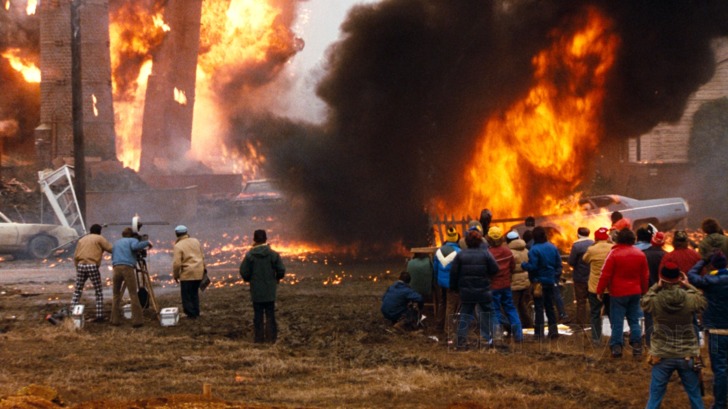
Hooper was shot by Bobby Byrne, reuniting with director Needham after Smokey and the Bandit.
Byrne would go on to shoot Sixteen Candles for John
Hughes and Bull Durham for Ron Shelton.
Consistent with the "laugh in the face of danger" work ethic of the stunt players that Hooper
celebrates, Byrne's lighting is consistently bright and cheerful and, unlike feature films where the
DP has to manipulate the photography to conceal the stunt double's face, Byrne went for the
clearest image possible, even amidst smoke and chaos.
Like Sharky's Machine,
Hooper was badly treated by Warner on DVD, released in only a bland
full-frame version. However, Warner's 1080p, AVC-encoded Blu-ray is one of their better
catalog efforts: newly transferred from a pristine source and featuring good detail and sharpness,
a natural grain pattern and a bright but not overly saturated palette that emphasizes the realism of
the stunt work. An alert viewer will notice that Hooper and his fellow stunt performers are
usually surrounded by red, white and blue, whereas the director, producer and studio "suits"
typically appear in grays and browns. The only questionable shots occur during the huge stunt
sequence filmed as the conclusion to the film-within-a-film at an abandoned military hospital
that the Hooper crew dubbed "Damnation Alley". With multiple cameras rolling on one-time-only "gags" and smoke from massive fireballs
swirling through the air, a few shots came out
grainier and less defined than others. Blu-ray can't improve on what was already there, and to
Warner's credit, they don't appear to have tried.
Warner Home Video has mastered Hooper with an average bitrate of 23.25 Mbps, which falls in
the middle of their typical range. One might expect a higher average for a film with so much
action, but the available bits seem to have been properly allocated between the quiet scenes
where Hooper banters with Gwen, Jocko or Cully and the major peaks where people and objects
go flying about the frame. Artifacts were not an issue.
Hooper Blu-ray Movie, Audio Quality 

Hooper's original mono track has been encoded as lossless DTS-HD MA 1.0, and it sounds quite good for its age. The snappy dialogue is clearly rendered, and the numerous crashes, punches, explosions and general mayhem register with enough force and dynamic range so that you don't feel let down. (Turn up the volume loud enough, and you may even rattle an object or two.) The soundtrack benefits hugely from the score by Bill Justis (who also scored Smokey and the Bandit), which deftly alternates between country twang and action/spy movies beats, including a pseudo-Bond theme that's better than some of the real ones. The film's theme song, written and sung by Brent Myggen, is a tribute to stunt men.
Hooper Blu-ray Movie, Special Features and Extras 
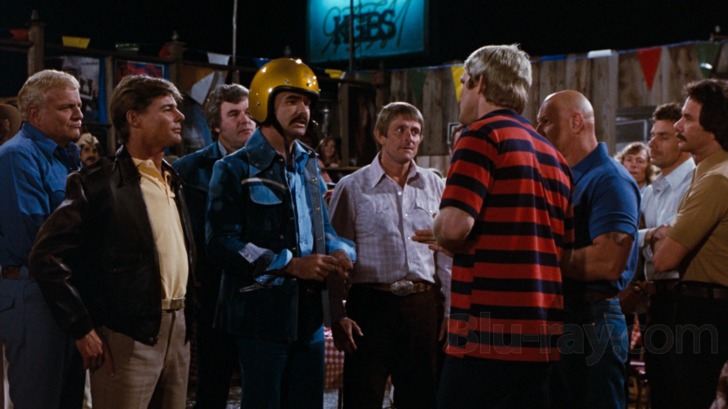
Except for the film's trailer (480i; 1.33:1; 2:00), the disc has no extras.
Hooper Blu-ray Movie, Overall Score and Recommendation 
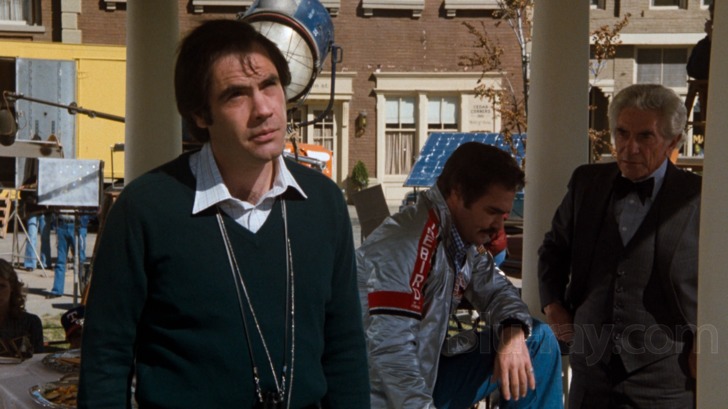
Hooper was one of the first films to run outtakes during the end credits, although they aren't
bloopers, just alternate takes of scenes in the film. Most are stunt sequences, a reminder, as the
long list of stunt performers scrolls by, of the thrill, the danger and, ultimately, the physical toll
that a stunt player's life entails. The film would make a great double bill with Richard Rush's
The Stunt Man, which came out two years later and
focuses more on the element of illusion that
is essential both to the art of stunts and to cinema in general. Both films feature megalomaniac
directors, and both are a lot of fun. Recommended.
Similar titles
Similar titles you might also like

Undercover Brother
2002

Johnny English Reborn
2011

CHiPs
2017

Smokey and the Bandit 4K
1977

Cannonball Run II
1984

Spies Like Us
1985

Ride Along 2
2016

Wrongfully Accused
1998

Ride Along
2014

I Spy
2002

The Spy Who Dumped Me
2018

Spy
2015

Mortdecai
2015

Spy Hard
1996

Top Secret! 4K
1984

Johnny English
2003

The Tuxedo
2002

Wild Hogs
2007

The Cannonball Run
1981

Bad Company
2002
